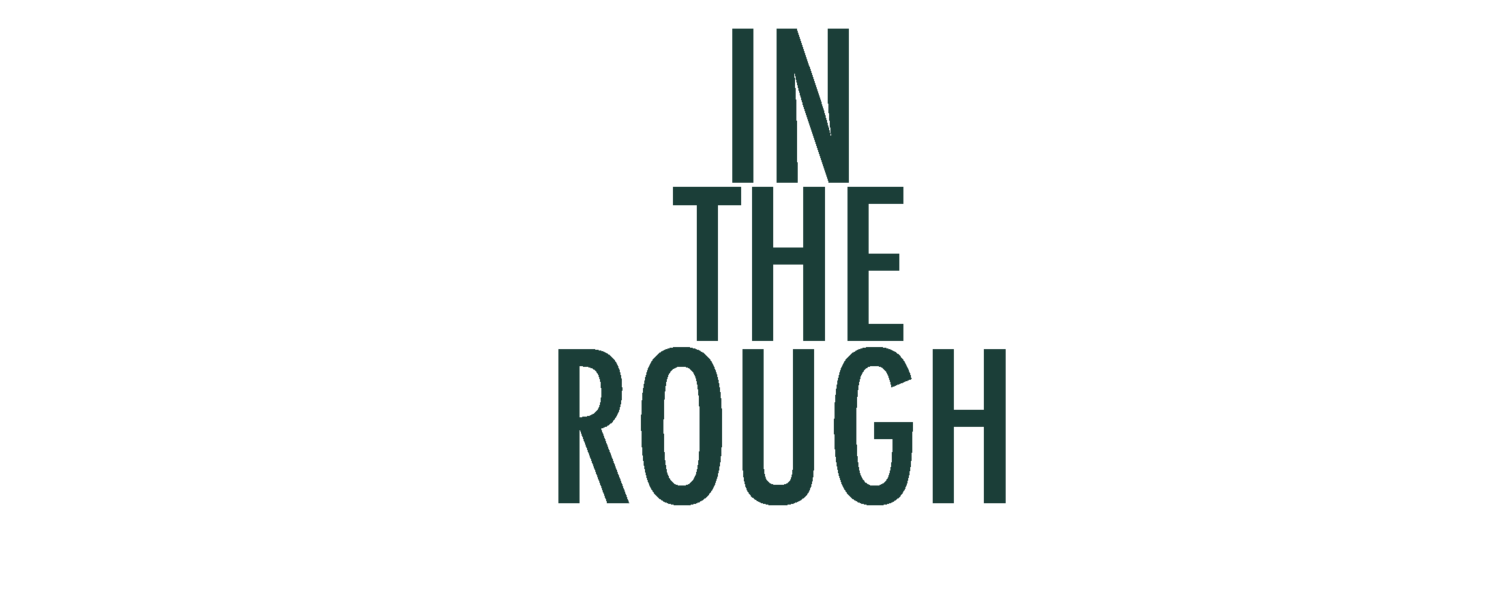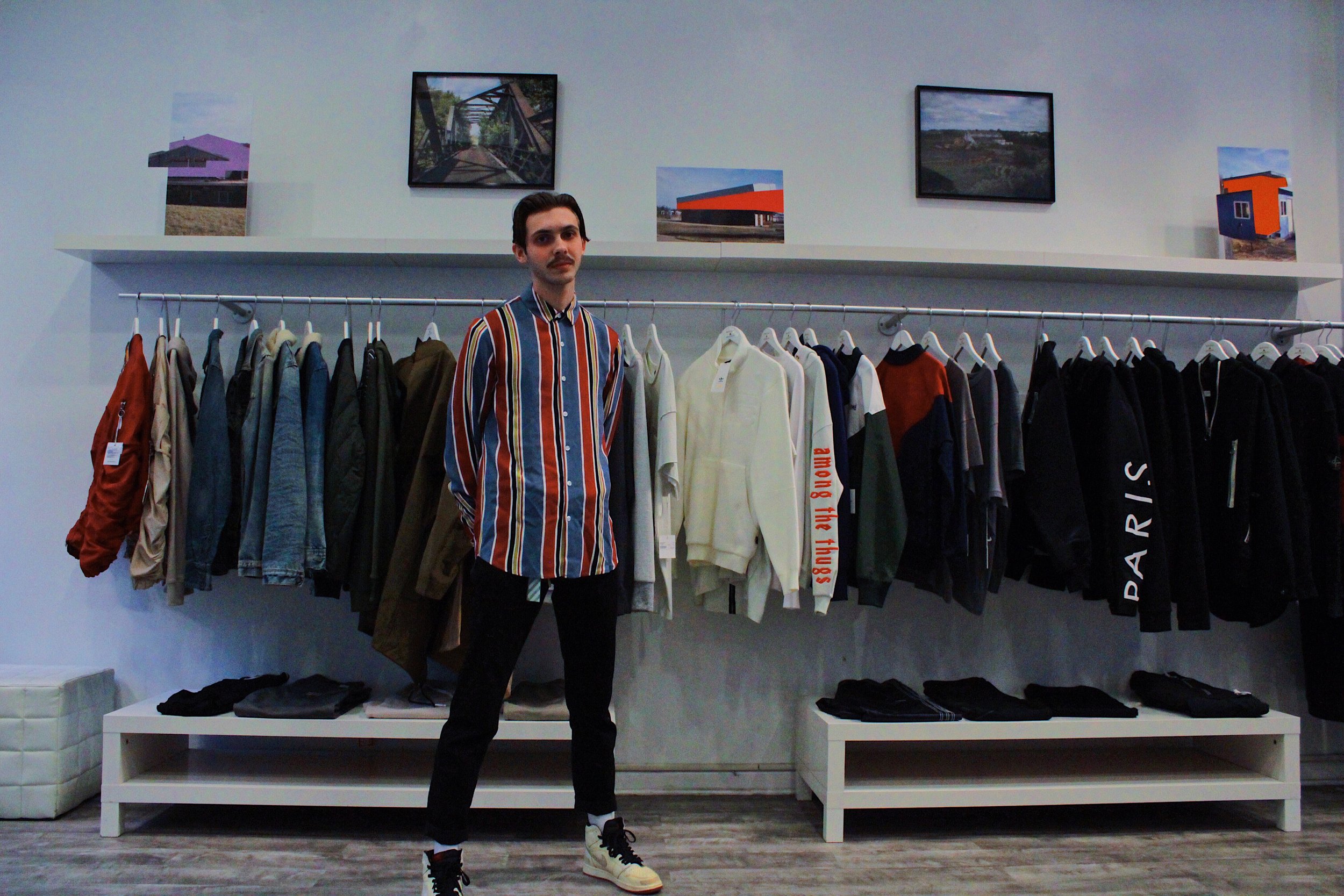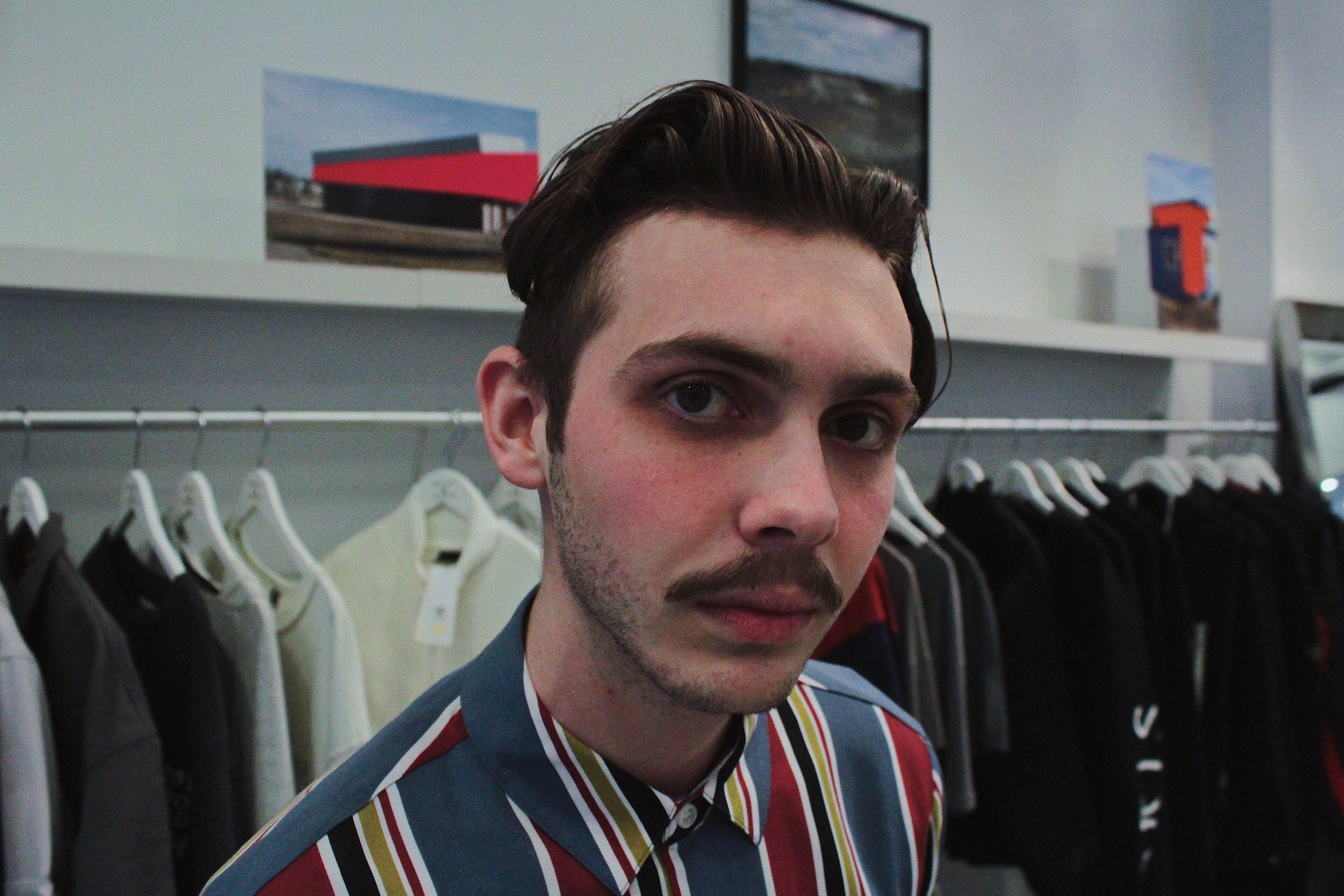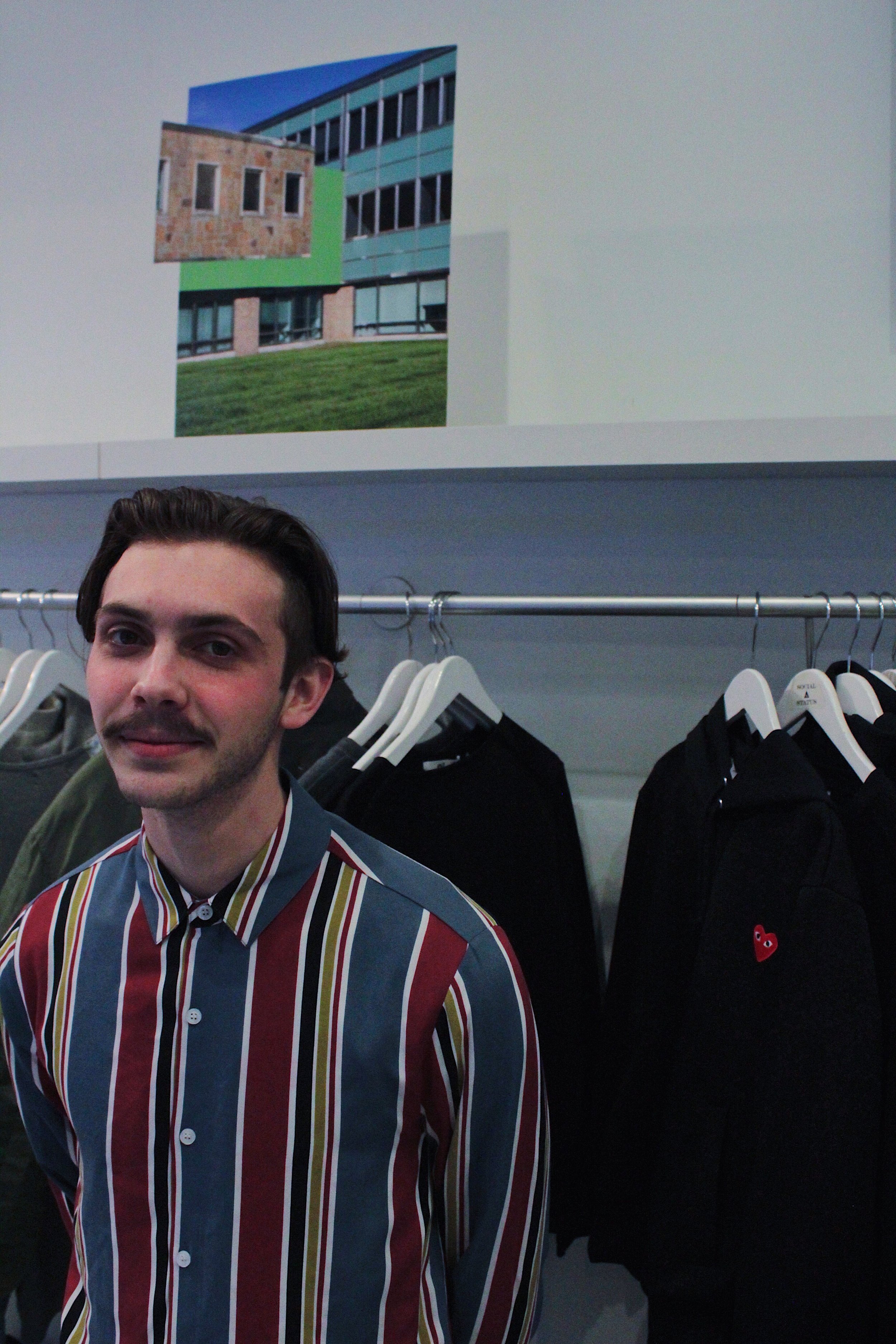Tyler Calpin standing in front of his pieces part of the “Searching for Jenny” exhibit at Social Status on Jan. 25, 2019. | photographs by Alex Young
Mid-show, he stops the conversation to cross the room and adjust one of his art pieces that shifted out of position from the significant crowd moving about the exhibit. Tyler Calpin was living out his dream of achieving his first solo show at a relevant destination for culture and community in Pittsburgh, the Social Status streetwear boutique. “It’s very surreal right now,” he described his emotions.
Inside the shop’s Downtown location last Friday, Jan. 25, 2019, Slim Tha DJ spun records for the young audience of artists and tastemakers supporting Calpin in his moment. Calpin showed “Searching for Jenny,” a photography exhibition dedicated to his hometown Youngstown, Ohio.
“Jenny” was the name of the last working blast furnace in the United States of America. The steel industry was vital to Youngstown’s economy and once it was shut down on September 19, 1977 it left a financial depression in the city. “There’s still a lot of stuff left over from it in terms of architecture or structures that are remaining that were around from that time,” Calpin said of the deteriorating, midwestern factory settings he photographed for his art. Calpin’s great-great and great-grandfathers worked in the Youngstown Steel mills. The work in “Searching for Jenny” connects Calpin to his family roots. Though his images focus on a past dead and gone, the colorful collage aspects to his art breathe life back into the buildings and parts that were lively about the Youngstown community before.
Honestly, Calpin is grateful for being able to leave Youngstown for Pittsburgh and add something to the culture here. While he’s doing his job at Social Status literally as a sales associate, the Pittsburgh transplant is also aware of the opportunities he has at the business platform to advance his own brand.
“For me, it’s just bringing people in and furthering the idea of community,” he said. It feels that way when potential customers walk in feeling welcomed, observing the sales associates, who are often local movers and shakers like Tyler Calpin or rapper My Favorite Color, openly converse about contemporary culture. “Whether it’s through fashion, sneakers or art… It started for me through skateboarding,” he explained. “All of these communities, as I’ve gown older, I can see how they all blend in a lot of ways.” Calpin’s location at Social Status makes him a familiar face when it comes to linking with other artists in these various scenes. “It shows people that we’re accessible and that we’re human,” he said. Calpin made the decision to utilize the shop for his artwork once he saw his college peer and fellow photographer Sharimar Cruz display her work there.
“I think consistency is important in photography whether it’s pictures of yourself or consistency in your content.”
Now, Calpin makes it work for himself in a “do-able” climate that’s not too busy or overwhelming like in big markets such as Los Angeles or New York. He meets his goals in Pittsburgh by “building genuine relationships, being yourself, and being consistent around those people,” he said. One of the relationships he’s continued to cultivate is with rapper Choo Jackson of ForeverKool Records. Calpin shot cover art, and merchandise looks for Choo. Next, he worked on Choo’s “Anime 2” album art with another artist Travis Carter. “I like to work with people who trust my ideas wholeheartedly,” Calpin said. “Be on the lookout for ‘Anime 2’ because that shit’s about to be fire,” he promoted.
Calpin wants to be known as “The King of the Midwest” stressing the value in regional notoriety rather than the coolness you get from being internationally or nationally recognized. With features in more shows, like those at Artists Image Resource gallery on the North Side on February 15 and April 12, he looks to expand to other cities like Chicago or Philadelphia. “I just want to keep producing work at the highest level possible,” he finished.
Tyler Calpin behind the sales counter at Social Status | photograph by Alex Young
Read the transcript of Tyler Calpin’s interview below.
InTheRough: You have the infamous selfie mirror over there. Please talk about that energy.
Tyler Calpin: So, I started taking the mirror pics everyday just to show off what I was wearing and to show people I was in the store. See if I could bring people in through my Instagram, which sounds so corny. It became one of those things that people started to respond to it. I was like oh this is actually kinda fun. It’s something I can do consistently. I think consistency is important in photography whether it’s pictures of yourself or consistency in your content. It was just one of those things. As soon as people would come in the store and tell me, “Oh, I saw your pic. I saw you were here. Oh, that’s a dope fit.” I was like okay I gotta keep doing this everyday. The daily fit pic (laughs).
ITR: How do you try to use your role at Social Status to further your brand?
Calpin: Ultimately, I’m just a sales associate, so I’m just here to help customers and make sales. For me, it’s just bringing people in and furthering the idea of community whether it’s through fashion, sneakers or art. That’s really important to me because all of those things are tied together in a lot of ways. It started for me through skateboarding. All of these communities, as I’ve gown older, I can see how they all blend in a lot of ways and how they take things from each other to kind of further itself. I always use the example of “clout bags.” You know, the shoulder bags. People in skateboarding were using those two or three years before hypebeasts or anyone like that.
ITR: Before rappers.
Calpin: Yeah, it’s something you can throw your camera, a bottle of water, your phone or your wallet in. Sling it across your back and just go.
Basically, my role here is bring people around and get them hip to shopping here. For me, I’ve always wanted to work here since I came to Pittsburgh. I bought my first Bape tee here. I was hooked. Being able to do that for other people makes me feel very validated in a lot of ways, which is crazy to say just working a retail job, but making someone happy through a material good is super awesome.
ITR: It feels like the new-age barbershop in here. You guys are in here choppin’ it up and when you come in that’s really happening.
Calpin: That’s how it is and that’s what’s really important to me. I want people to feel like they can come in here and just say hi and hang out for a little bit. Have a conversation whether it’s about personal things or they want to chop it up about the culture, sneakers or whatever. That’s basically what we’re here for and that’s what’s really important to me. It shows people that we’re accessible and that we’re human.
[Playboi Carti’s “Yah Mean” plays in the background.]
ITR: How does it feel to achieve a goal? That goal being your first solo art show at Social Status because you’ve been striving for this for a couple years.
Images from Youngstown, Ohio by Tyler Calpin
View more work at his “@lil35mm” Instagram handle.
Calpin: It was one of the first things when I was living in a dorm room at Point Park [University] and I started coming here and being able to look at this stuff I couldn’t afford it then but it was so nice to be able and come and look and not feel like I wasn’t welcome here. Once I started to see they were part of the gallery crawl and it doubled as a space that was not only for sneakers and fashion culture, but for art as well it was important for me to get my work and myself in here. What really inspired me was seeing Shar [Sharimar Cruz] do her work here. She went to Point Park and I was in classes with her. Seeing how accessible it was to people that are around in the Downtown area, but Pittsburgh in general. I came here, I saw what I could do, and I set out to get that goal. It took longer than I wanted it to, but that’s how things go sometimes.
ITR: Yeah, time.
Calpin: Time is really important. Believe me, when I was 17 years old, I would’ve loved to have solo shows. But I didn’t have the knowledge. I didn’t have the resources. I didn’t have any idea of what it really took. Now, five years later I’m 22 years old and I have that knowledge. I have those resources and I have the capabilities and the ability to cultivate the opportunities to make those kind of things happen. Being able to have my first solo show here means a lot to me. It was that first place that really struck me I was like, “I gotta do it.” It’s very surreal right now. Seeing it on the walls is just crazy right now.
ITR: What does it mean to debut “Searching for Jenny” in Pittsburgh? Obviously you go to school here and you lived close by being from Youngstown. When’s the first time you saw Pittsburgh as an opportunity?
Calpin: I would say I saw Pittsburgh as an opportunity the second I started coming here. My friend Ben and I would come out on random Saturdays. We would come out when it’s this cold outside. For the record, it’s like single digits right now. We would come out we’d go to the South Side. Go to the skate shop. Get Primanti Bros. Go to the Strip District. Stuff like that. It just seemed like one of those cities that it was do-able. It’s bigger than Youngstown, but it’s not like L.A. or New York where things are so overwhelming or super busy. Once I got to Pittsburgh in 2015, I started to see people who I was close with getting opportunities. I was friends with a lot of the juniors and seniors when I was a freshman. That was when they started to get their solo shows and group shows and their opportunities. As soon as I started to see it work for other people, I knew it could work for me too. All it took was talking to the right people and being genuine. If I could tell myself that years ago, I would run with that information. Truthfully. If all I knew it took was building genuine relationships, being yourself, and being consistent around those people…
ITR: That’s the big part about it.
Calpin: Yeah, it’s really important to continue to cultivate those opportunities. It goes back to that community that we have here. When people stop in once or twice a week that’s awesome. We have people that come in if they’re Downtown they’ll stop in just to say hi. That’s really important because those are people that I know that care about us as human beings and they know we’re something more than just sales associates. We’re human beings and creatives as well. When people can see that about you and they’re more interested in your personal life than what they can get out of you at the store, that’s really important.
ITR: What’s your ultimate goal?
Calpin: My goal is to keep doing this shit man. I just want to keep producing work at the highest level possible whether that’s conceptually or just producing a lot of things. I have my hands in a ton of stuff right now. I want to keep it that way. I just want to keep it moving and see where it takes me because that’s what got me going in the first place and that’s going to keep me afloat. Ultimately, my goal is to keep doing shows whether it’s a group show or a solo show. Ideally, I want to be the king of the Midwest. I want my work to be known in a region. Being national and international is so cool, but that takes a lot of time. My goal after Pittsburgh is going to somewhere like Chicago or Philadelphia. I want to do some stuff in Cleveland and especially in the Youngstown area. I do plan to show this work in the Youngstown area because it would be so stupid to not show it there. Not only do I want the people of the area to see it and appreciate it, but I just want them to see someone from Youngstown started there, went somewhere else, did something with their life, and is paying it forward in a lot of ways. I’d like to see myself curate shows as well. That’s something that I do like to do. But, yeah, I just want to expand regionally before I start to make the jump nationally or internationally.
ITR: What’s your role with Reviving Real?
Calpin: Specifically with Reviving Real, I do a lot of the photography work almost all of the photography work. You know, just pushing the product and getting people hip to the idea that we’re not only a clothing brand, but we’re a media platform at this point. The clothing is more like merchandise to the platform We do artists’ spotlights, blog posts, and we just partnered with Matt’s Music Mine. I know he’s a great journalist so that merging of music and journalism and culture it’s really important. We make promotional videos. We help people build electronic press kits. People that are looking to expand how they advertise themselves and what they do whether it’s through music, photography or art. We help people get the resources to make those things happen. We also consult people. We’ll sit down and have a conversation with you for a small fee. That knowledge is so valuable. What’s 50 bucks for a two-hour conversation that could turn into 500 or a thousand dollars in two months if you really use that to your advantage.
Alex Young (left) and Tyler Calpin (right) in front of the infamous fit pic mirror at Social Status. | photograph by Tyler Calpin
ITR: How else do you plan to add to the Pittsburgh culture. You’ve worked with people in the scene like rapper Choo Jackson or you’ve done lookbooks for brands like vintage shop Senseless. How will you continue to use yourself as a resource to the community?
Calpin: Keep doing stuff like that to be honest with you. I don’t like to close myself off from people, but I like to work with people who are genuine, believe in me, and trust my ideas wholeheartedly. Keep doing work with people that trust me to come to the table with ideas knowing that I can produce it and make it a reality. People that are open to me and don’t think my prices are too high and understand why they are that why. I don’t ask for what I ask for just because I have bills to pay. It’s the level of the work that you’re going to receive. I’m not trying to be full of myself. You know what you’re going to get for that price and it’s not going to be some bottom of the barrel shit. You can find someone that’s gonna do it for 50 bucks and it’s gonna look like it’s 50 bucks. If I’m asking 300 or 400 dollars it’s going to look like a three or 400 dollar job. I’m not going to put 20 minutes into it. I’m going to make it my life for a week and a half if I have to to make it the product you want. If we have to go back to the drawing board, then so be it. I want people to be happy with what they receive from me, but also happy with what they’re paying for. I like to sit down with people in a pre-production meeting and talk about the ideas before we even touch a camera or open up my computer and start doing things. I’m very into that idea of making sure I deliver a product that my clients are happy with.
ITR: Respect. There’s nothing wrong with knowing your worth.
Calpin: I don’t know if I can say this, but I did do the “Anime 2” cover in a collab with another artist. His name is Travis Carter. Choo hit me up with idea and was like, “Hey I really want to use your collage style,” and I was like yeah, let’s do it. That’s something that I’ve done for him before. It’s obviously something that people respond to. I made the collage. I sent it off to Travis. He did some things with it and all I have to say is the final product looks really dope. So be on the lookout for “Anime 2” because that shit’s about to be fire.
[Tara Fay, a Social Status manager, offers Tyler Calpin dessert humus.]
ITR: Can you briefly touch on the color in your work?
Calpin: You know, basically, I’m ripping these structures a part in an area that feels slightly deteriorated and it’s not the way it used to be. A lot of things have changed since the steel industry left. There’s still a lot of stuff left over from it in terms of architecture or structures that are remaining that were around from that time, but there may not be a business in it. So, I photograph these structures. By cutting them at these really important seams, that’s why a lot of it is cut at the corners or where things start to intersect, I pull them a part there and I put the color behind it to in essence to breathe life back into it. I feel like color is one of those things it’s very lively. So many of the colors I’ve chosen are really vibrant.







